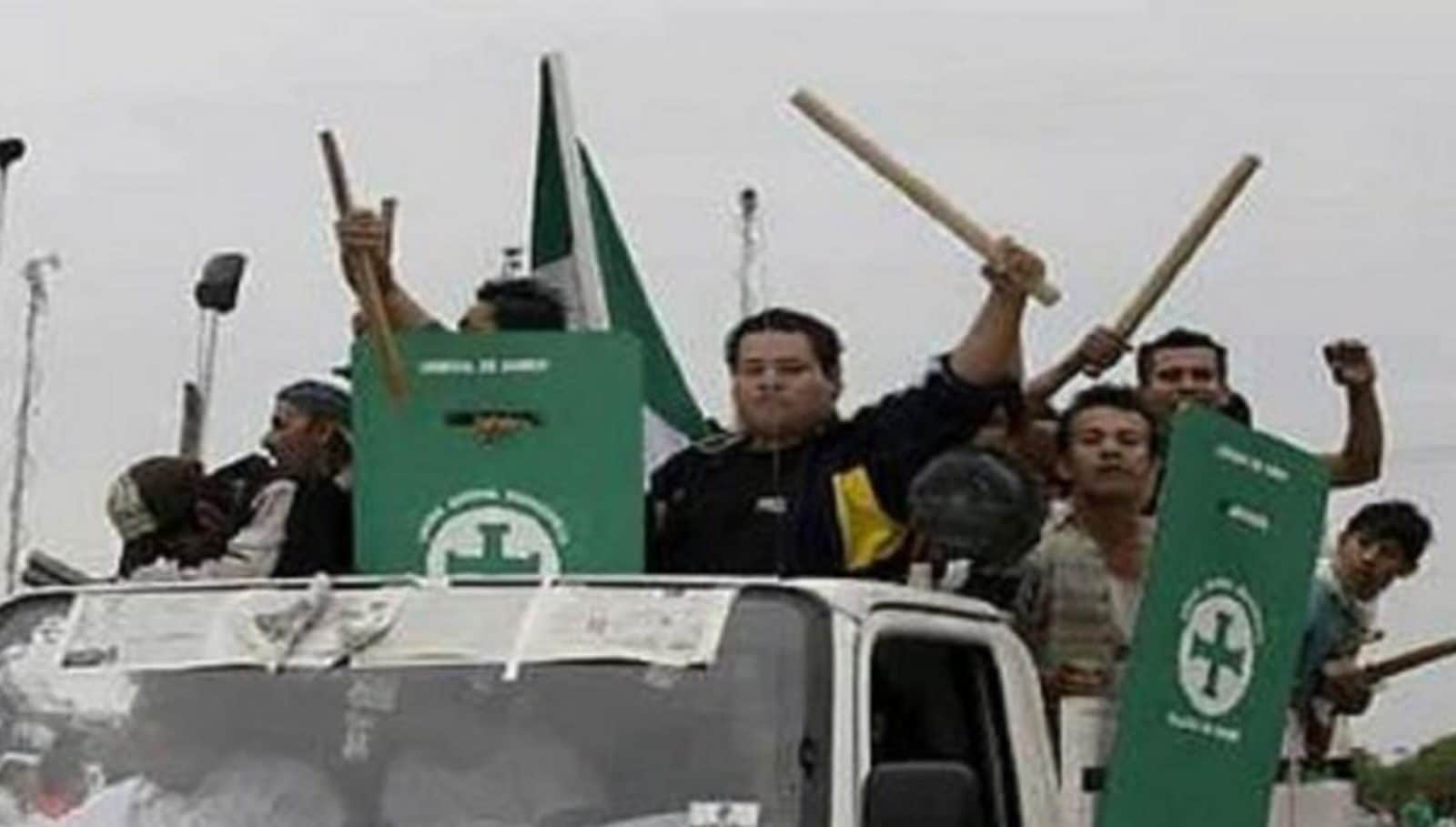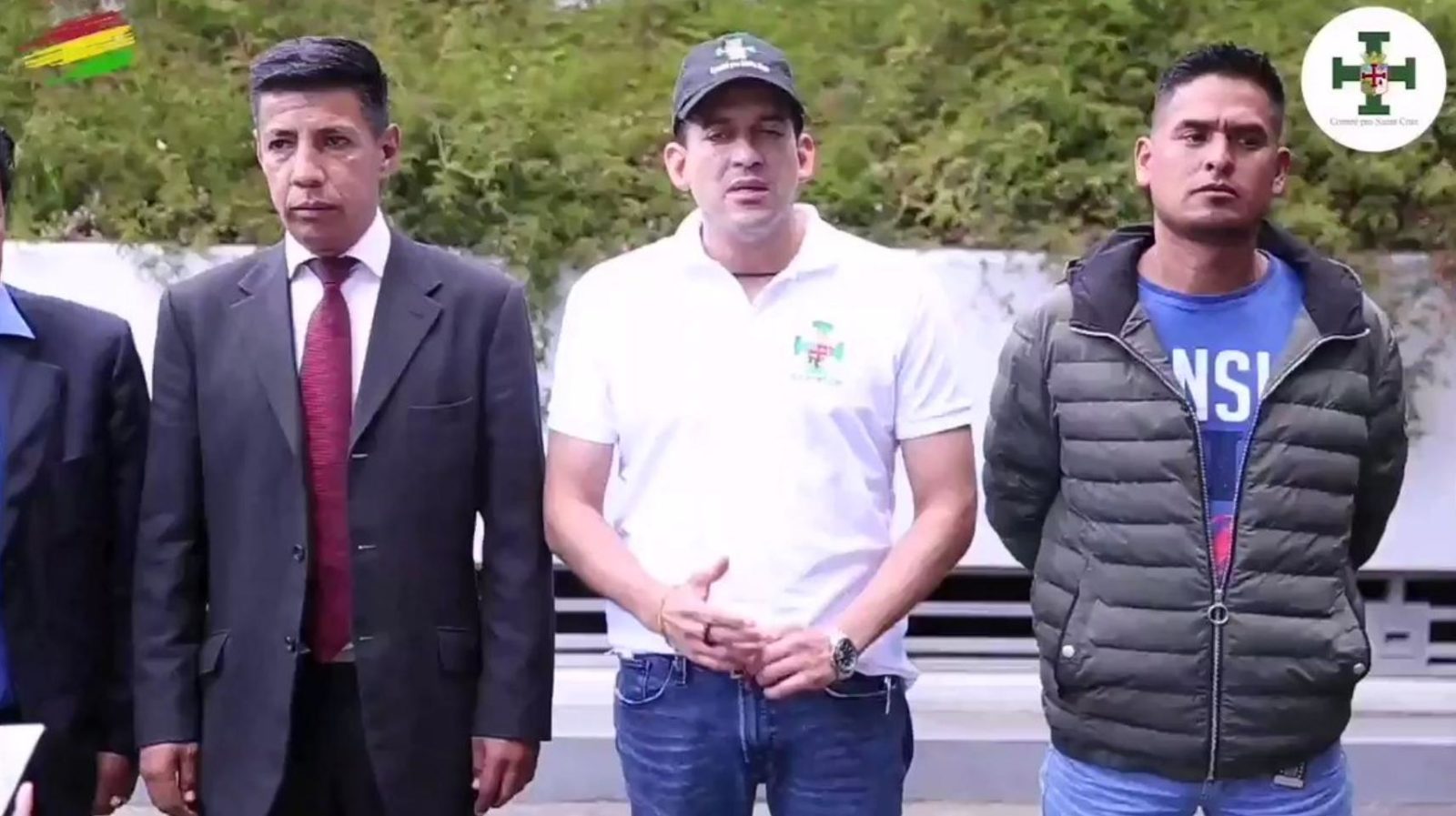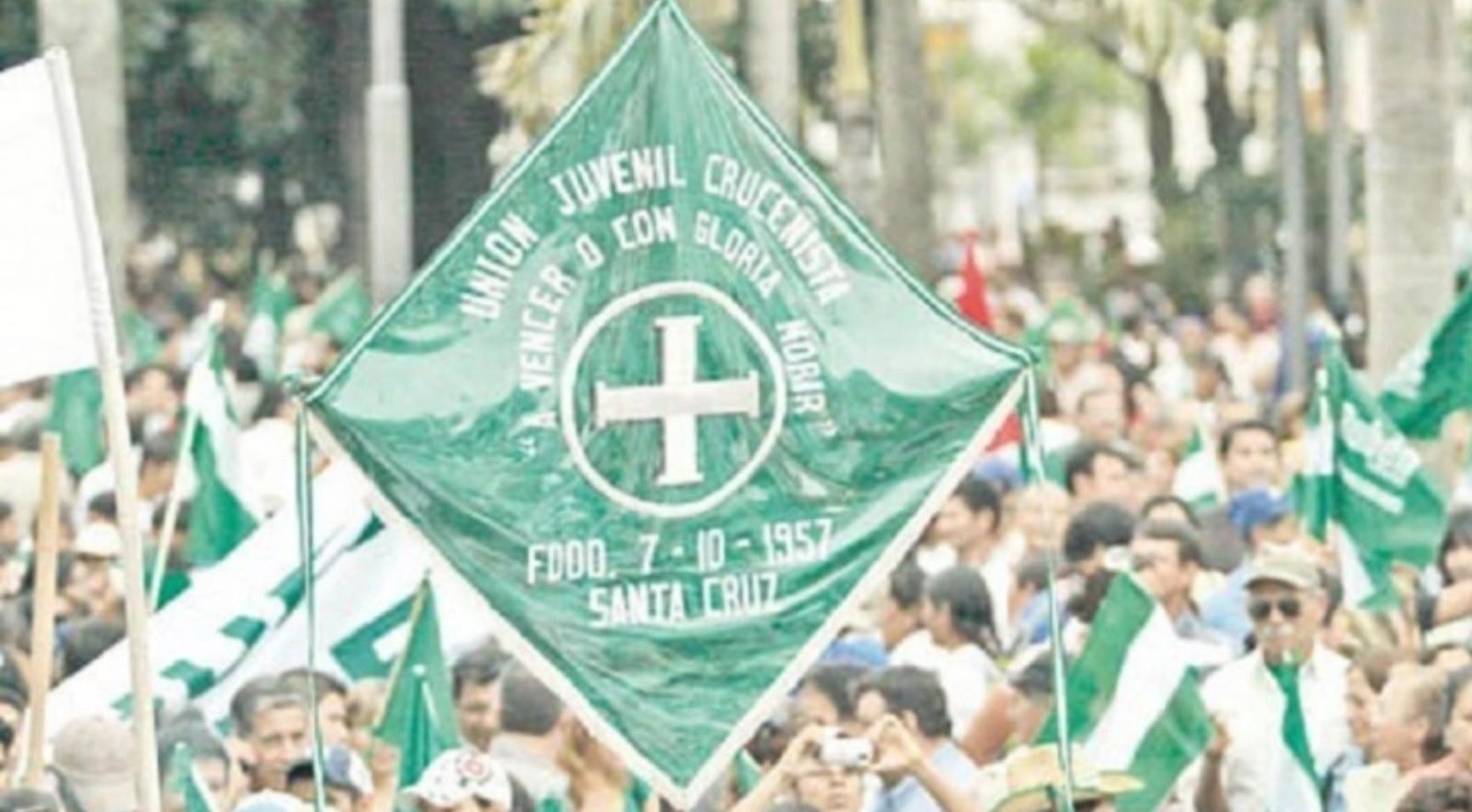
By Nicolas Lantos – November 24th, 2019
On the chest of the coup plotter Luis Fernando “Macho” Camacho, at the height of the heart, there is a green cross. It is the shield of the Cruceñista Youth Union, a paramilitary organization of the Bolivian, racist, separatist and anti-communist oligarchy, (with ties that go back to Francoism and reach the neo-Nazi groups that proliferate in Eastern Europe, passing through the torturer of the Gestapo, Klaus Barbie) which has been operating in Santa Cruz de la Sierra for more than six decades.

The UJC was founded in 1957 within the framework of a bloody confrontation between Santa Cruz and the central state for royalties from the exploitation of hydrocarbons. This conflict runs throughout its history and in the 21st century, this shock force has become the spearhead of the autonomous sectors that promoted and staged two coups against Evo Morales, driven, now as then, by the demand for a greater share in the profits of oil and gas.
The man of the cross, who entered the “Palacio Quemado” with a Bible in his hand thus consummating the overthrow of Evo Morales, is heir to one of the families that produced in the gas business until its nationalization by Morales himself. During the months prior to the coup, in meetings with foreign investors and diplomats, Camacho anticipated the priorities of the new government: among others, to reprivatize those companies. There is already a draft of the proposal on the desk of Senator Jeanine Áñez.

The Union was the lead agent of the armed uprising against Morales since before it came to light. At least as of May, there is a record that Camacho participated in negotiations with local and foreign political actors, security forces and military, seeking support. At the same time, the groups of crusader clashes increased the frequency and intensity of their attacks on local MAS and private homes of leaders and militants of the ruling party. The coup machinery was already activated.
Some striking chronological coincidences tell of pre-meditation. The Cruceñistas opened their accounts on Twitter and Instagram simultaneously on October 17, just three days before the elections that marked the start signal for the coup. In 2008, on the eve of the Separatist asylum, the Wikipedia entries of the UJC and the Pro Santa Cruz Committee, the political branch of the same movement, were created. The technologies used changed, not the tricks.
In a documentary of just over twenty minutes that appears in the networks as a presentation, the Union is defined as “the instrument of struggle” and “the arm of steel” of the Committee in its crusade against the “forces of evil.” In the final minutes you can see scenes of the paramilitary formation of its members. Another video they uploaded, already published in “El Cohete a la Luna” last week, shows them performing the fascist salute with the extended right arm.

The UJC recruits youths from Mendoza between 17 and 36 years old. They boast of having 80,000 members. Camacho was the youngest vice president of the organization, at the age of 23. He remained in office for only two years and then continued his political career in the Committee, although since then he remained as a political youth leader. Another temporary curiosity: his arrival in power, in 2002, coincides with the beginning of the stage of separatist radicalization of the local elite, which would conclude in the 2008 coup attempt.
The history of Camacho has some points of contact with that of Juan Guaidó, the Venezuelan deputy who takes over the presidency of that country. In a report from The Grayzone site, journalists Max Blumenthal and Ben Norton highlight it: “Like Guaidó, whom more than 80 percent of Venezuelans did not know before he was appointed by the U.S. government as supposed ‘President’, Camacho was an unknown figure in Bolivia until the coup attempt.”
However, in other aspects, the most accurate comparison would be with Henrique Capriles or Leopoldo López, like Camacho, heirs of traditional families and possessors of enormous fortunes. The three share, in addition, the violent methods, the little attachment to democracy and the look of the good South American coup plotter: sports shirt and baseball cap. To this combo, in the Bolivian case we must add a strong racist component, which is not new in the convulsed history of the “civic” movement in the Bolivian east.

Behind the burning of Whipalas there is an ancient tradition of racial and class hatred. The founder of the UJC was Carlos Valverde Barbery, leader of the Bolivian Socialist Phalanx, a nationalist group created in the 1930s in the image and likeness of the Francoist brigades in Spain. Already in the twilight of his life, Valverde Barbery would end up being Minister of Health for the dictator Hugo Banzer, until he was arrested by Interpol at El Alto Airport in possession of a briefcase full of cocaine. The Chilean branch of the Falange, headed by Senator Jaime Guzmán, was responsible for the Pinochet Constitution, which today the Chilean people demand to repeal.
The Falange counted among them the famous Klaus Barbie, who arrived in Bolivia in 1955 with a false identity and safe conduct of the CIA. The former Gestapo would remain in La Paz for almost three decades and would be the protagonist of the coup d’etats of Banzer (in 1971) and Luis García Meza Tejada (in 1980). In the same way, facilitated by the United States government, several members of the Ustacha Nazi-Croatian group took refuge in the country. They chose to settle in the city of Santa Cruz de la Sierra and soon felt comfortable in the Committee.
A prominent member of this community is Branko Marinkovic, an oilseed entrepreneur and landowner who has sponsored Camacho throughout his career. Their trajectories are parallel: Marinkovic began to finance and get involved in the separatist groups of Santa Cruz after Morales expropriated part of his land in the framework of agrarian reform. His plans, thereafter, aimed to reissue from Santa Cruz the fight of his Croatian ancestors to separate from the rest of Yugoslavia.

Marinkovic has denied in several interviews that his family had collaborated with the Germans and has insisted that his father was a partisan who fought the invaders. A document from the private intelligence agency Stratfor, leaked by Wikileaks, warns, however, that probably “their parents are first generation” of immigrants who “were supporters of the Ustacha (ie: Nazis) and fled from the communist regime of Tito after the Second World War”.
When Morales came to the presidency and began with his nationalization plans, in 2006, Marinkovic took charge of the resistance. Already by then, in a note to local media, the businessman warned that “land reform can lead to civil war.” Once the expropriation was completed, he turned his forecast into reality. By 2008, Marinkovic became President of the Pro Santa Cruz Committee and began the separatist plans. As now, the kickstart was an election. Marinkovich’s mother and Camacho’s father are partners in an offshore registered in Panama by the Mosack Fonseca study.
On August 10 there was a recall referendum on the authority of President Morales and the departmental prefects that had strained their relationship with the central government by unilaterally proclaiming autonomy. Both the national president and most of the governors were ratified. Nine days later protests broke out in the so-called Middle Moon of the East, the hydrocarbon states of Santa Cruz, Beni, Pando and Tarija. Marinkovic’s civil war was under way.
For a month, paramilitary forces such as the UJC were at the forefront of the coup: they intervened in the sabotage of the Tarija pipeline, seized the Vuelta Grande gas plant, occupied government buildings, attacked officials, ambushed government support rallies and unleashed pogroms against the local indigenous population. The exact number of deaths caused by these crash groups is still unknown. Hundreds of Bolivians and Bolivians still remain missing.
The coup was suffocated in mid-September. Seven months later, the Bolivian police broke up a plan to kill Morales. The executors were five European mercenaries linked to neo-Nazi groups: the leader of the group was a former Hungarian-Bolivian left-wing journalist, Eduardo Rosza-Flores, who ended up in the ranks of Opus Dei and with Croatian nationality in recognition of the services that Toasted in the Balkan War. His code name during the operation was “Franco”.
The subsequent investigation determined that the frustrated murder had two terminals. Abroad, Rosza-Flores’s contact was Itsvan Belovai, “a former intelligence officer of the Hungarian army acting as a double agent of the CIA,” according to Blumenthal and Norton. Within Bolivia, as determined by Justice, those responsible for financing the attack were the governor of Santa Cruz, Rubén Costas, and his friend and partner in agricultural business, as well as the head of the Committee: nothing less than Marinkovic himself.
In order not to face the consequences of this judicial investigation, Marinkovic fled Bolivia to the United States, more precisely to the state of Texas, where he had spent time in his youth as a student. There he was temporarily isolated until he decided to return to Brazil, where he established a personal and political bond with the then deputy Jair Bolsonaro. In his absence, Luis Camacho was his man in Santa Cruz, plotting for years until he found the right time to execute his plan.
The objective was threefold: to get rid of Morales, recover his lands and return to his country. Bolsonaro’s rise to power opened the window of opportunity. The need to curb a populist reflux, given the triumph of Peronism in Argentina and the freedom of Lula in Brazil, led to undoubted support from the State Department. The region, on fire, provided a suitable scenario. As in 2008, the elections were chosen again as the excuse chosen to launch the final stage of the coup.
Last Wednesday Branko Marinkovic ended his exile and returned to Santa Cruz. On the same day, the Christian Democratic Party announced his candidacy as governor. “It is not the time for candidacies, it is rather the end of rescuing democracy, which is still threatened by the violence incited by narco-cocalero leader Evo Morales,” he declaimed. The one who prepares his presidential nomination for the next elections, with Morales outlawed, is Camacho, the man of the cross.
Source URL: El Cohete a la Luna
Translated by JRE/EF
| Website




